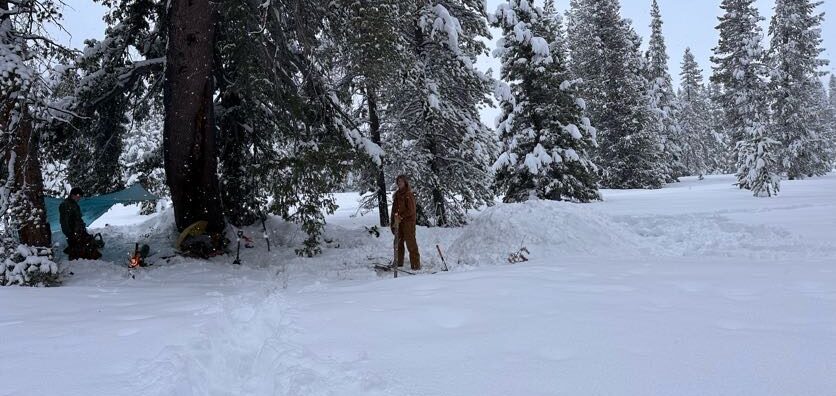When I tell anyone about this trip, they usually say something like, “That sounds cold” or “I’m not going.” There are a select few that are dumb enough actually to go on this trip with me. For this trip, I brought my friends Tyler and Mayer. This is one of those trips where I can’t even guarantee a good time; the stories that come from my annual winter camping trip every year are legendary.
Here are some logistics for anyone trying to make one of these trips. We started in Boise and camped in the National Forest between Sun Valley and Stanley; there are plenty of spots to pull off here. Most of the time, the pass known as “avalanche alley” will be closed after a heavy snowfall. This is the section of Highway 20 that goes from Lowman to Stanley. This means if you are coming from Boise, you must travel through Sun Valley instead. You can always check the road reports and webcams before you travel in the winter. For gear, we went privative. We brought axes, snowshoes, shovels, food, sleeping bags, and clothes. The beauty of this trip is keeping it simple. Your first year of winter camping, you should bring a lot and come completely prepared.
Here are some things you should bring that are specific to winter camping: Two sleeping bags if you don’t have a very warm sleeping bag. An extra set of every piece of clothing you will be wearing. Snowshoes so you can actually get to where you want to camp. Lots of extra food; you will be burning a lot of calories. I bring all my snowboarding gear and mix in my other adventure clothing.
It started like most expeditions, loading up the 4 runner with gear and friends. We then started the drive to Stanley at about 9 am. On the way to Stanley, we thought, “What if we just made an igloo?”. We started researching how to make an igloo. It’s pretty easy. We also figured out on the drive towards Sun Valley that the roads from Sun Valley to Stanley would be nasty. We realized we should look for a spot to start our trek right after passing Sun Valley.

After passing Sun Valley, we found a nice pullout on land owned by the National Forest. When we go winter camping, we usually try to look for very mellow terrain; walking in deep snow is exhausting. We finally found a suitable spot and started hiking. We hiked for about a mile on a man-made snowshoe trail and then veered off into the deep snow to find a camping spot. After two miles of hiking, we found a perfect place to start a fire and build our igloo. As soon as we got there, Mayer began to working on creating a fire for cooking. Tyler and I started making a mound that would quickly become an awesome snow hut. After the mound of snow reached our heads, we took about two hours to let the snow settle and compact. This is essential to making sure your igloo doesn’t collapse. While we let the snow compact, the fire started to roar. After the snow settled, Tyler and I started carving out the inside of the snow hut we were going to sleep in. It is vital to make sure that all of the walls of the snow cave are the same thickness; we used an avalanche probe to check the depth. This process of digging from inside the cave is not dry, so bring extra clothes that you are alright with getting wet.

The cave was finally dug out after about an hour of Tyler and I working our hardest. Mayer constructed a homemade bench out of wood and rope perfect for cooking dinner. We then started cooking the steak and potatoes on the fire, with no stove. The steak was fantastic, and we were almost ready for bed after a long day of construction. Getting into the snow cave was tight but significantly warmer than outside. Putting candles in your snow cave is an easy way to make it more structurally sound by adding a layer of ice to the inner walls. After settling in, we closed out the night with a rave in our snow cave.

The following day, we woke up and started packing up. The nice thing about a snow cave is that you don’t have to take down a tent in the morning. Packing up was complete; it was time to trek out of the commune that we had created. The trek out was uneventful; we took turns pulling the sled and walking through the waist-deep snow. When starting a snowshoe hike, wear as little as possible regarding clothing. You will get much warmer than expected no matter what you do. I like to wear only thin, water-resistant layers and base layers. Overall, it snowed about 2 feet while we were there; despite this, the trip went well.

Shoutout to Mayer and Tyler for always being down for my dumb ideas. If you have any questions about the trip’s logistics, send me an email or DM me on Instagram.


